Scranton native Jerome Mullaney desperately wanted to be like his older brothers and serve the country during World War II.
His parents allowed him to enlist in the U.S. Naval Reserve at the age of 17. Less than a year later, his mother answered the knock on the door that any military family dreads.
Two days after Allied Forces invaded Normandy, France, a German mine exploded near the stern of the USS Glennon, a Naval destroyer assigned to participate in D-Day operations. The explosion sent 16 sailors into the water off the French coast — including Mullaney.
His remains sat unidentified until this year. More than 80 years after his death, family will gather in Scranton on Sept. 3 as Mullaney receives full military honors as he is buried in his hometown.
“It provides closure to me,” said Mary Louise Brambilla, Mullaney’s niece. “This has been something that has bothered me.”
Military assignment
After attending Naval radio training in Bedford County, Mullaney joined the crew of the USS Glennon. As a seaman 2nd class, he helped with upkeep and operations of the ship. He stood watch as lookout, telephone talker and messenger. He also served as a member of a gun crew.
The military assigned the warship, a Greaves-class destroyer, to participate in Operation Neptune, the naval component of the allied landings on D-Day.
Once in position off the coast of France, Glennon supported landing forces through screening and patrolling for enemy submarines and fast German torpedo boats from June 4-6, 1944, according to military records.
By mid-day June 7, 1944, Glennon provided shore fire support to advancing Allied ground troops, firing at enemy positions and helping to stop a German counterattack.
On the morning of June 8, a mine exploded near the stern, sending 16 sailors into the water, some thrown as high as 40 feet. The military determined that Mullaney was lost at that time. The ship sank on June 10, suffering a total of 25 lives lost and 38 wounded.
A knock on the door
Two representatives of the military knocked on the door of Mullaney’s home in Newark. The family split time between Scranton and New Jersey. His mother, Mary, fell to the floor.
“She heard her doorbell ring, and she looked, opened the door,” said Brambilla, who lives in Shrewsbury, New Jersey. “She closed the door immediately. She did not want to know which of her sons was dead, but she knew that one of her sons was dead.”

Mullaney had been reported missing after the explosion. By August 1944, the Navy declared him a casualty of the war.
As the other Mullaney brothers returned home, family members kept photos of the youngest brother in their wallets. Brambilla was about 8 years old when her uncle died, and remembers her grandmother placing a sign of mourning in the front window.
Closure for family
For eight decades, the family lived without the closure of putting Mullaney’s remains to rest. This spring, remains found nearly 70 years ago finally received a name.
In 1957, pieces of the ship were hauled to shore by salvagers at St. Marie du Mont, France. A local resident found human remains in part of the ship. The Navy at the time could not identify them, and recommended the remains be interred as “an Unknown.”
In 2022, the Department of Defense and American Battle Monument Commission exhumed the remains from the Ardennes American Cemetery in Neupré, Belgium, and transferred the remains to the DPAA Laboratory at Offutt Air Force Base, Nebraska.
Scientists looked at the remains’ DNA sequence and compared it with the other sailors killed in the attack and with samples collected from maternal relatives of Mullaney. He was positively identified on March 26, 2025.
Family will gather at 11:30 a.m. on Sept. 3. at St. Mary’s Cemetery, 1341 Stafford Ave.
“After 81 years, there is finally some closure,” said Mary Louise Brambilla’s husband, Ray. “He's going to be buried in the same cemetery that his parents are buried.”
“So he's home,” Mary Louise Brambilla said.


